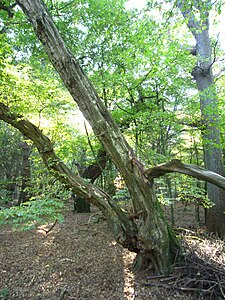Baumweg (nature reserve)
|
Tree path
|
||
|
Primeval forest in the NSG |
||
| location | North-east of Cloppenburg , Cloppenburg district , Lower Saxony | |
| surface | 61 ha | |
| Identifier | NSG WE 061 | |
| WDPA ID | 81375 | |
| Geographical location | 52 ° 54 ' N , 8 ° 9' E | |
|
|
||
| Sea level | from 43 m to 49 m | |
| Setup date | June 30, 1938 | |
| administration | NLWKN | |
Baumweg is the name of a nature reserve in the Lower Saxon community of Emstek in the Cloppenburg district . The nature reserve is named after the forest area of the same name .
The nature reserve with the registration number NSG WE 061 is around 61 hectares in size. For the most part, it is also designated as a FFH area “NSG Baumweg”. 37.5 hectares of the nature reserve also form the "Urwald Baumweg" natural forest reserve, which was designated in 1998 . The initially 57.8 hectare area has been a nature reserve since June 30, 1938. The nature conservation ordinance was updated in 2018 and the area a. increased to around 61 hectares by including an area within the area that was not previously under nature protection. The responsible lower nature conservation authority is the district of Cloppenburg.
The nature reserve is north-east of Cloppenburg on a Geest ridge in the west of the Wildeshauser Geest Nature Park . It represents an old book - oak forest with stalk and sessile oak and hornbeam as the dominant tree species with sometimes more than 200 year-old trees protected. Besides oak and hornbeam also is Rotbuche an often occurring here deciduous tree, which, however, was reinforced after the Second World War introduced by afforestation in the forest. The holly is represented in large numbers. Partial areas of the forests are pronounced as grove-beech forests , small areas of bog forest can also be found. The area designated as a natural forest shows historical hut forest structures. Around 28 hectares of the approximately 38 hectare natural forest area were no longer used for forestry well before they were placed under protection in 1938. Parts of the natural forest were lost in the post-war years due to the use as firewood or reparation cuts.
The forests in the nature reserve are not managed. They have a high proportion of old and dead wood . The forest is very important for cave-breeding species of birds, wood-inhabiting insects and fungi , including Laetiporus , Oak tinder , Oak random Ling and Riesenporling , as well as mosses and lichens . The forest is the hermit's habitat .
The area is completely surrounded by other forest communities in the "Baumweg" forest area. In the south it borders on the federal highway 213 .
Web links
- Nature reserve "Baumweg" in the database of the Lower Saxony State Office for Water Management, Coastal and Nature Conservation (NLWKN)
Individual evidence
- ↑ a b NSG Baumweg , profiles of the Natura 2000 areas, Federal Agency for Nature Conservation . Retrieved November 9, 2018.
- ↑ a b Profile of the Urwald Baumweg natural forest , database of natural forest reserves in Germany, Federal Agency for Agriculture and Food . Retrieved November 9, 2018.
- ^ The four primeval forests in the northwest , leaflet of the Lower Saxony State Forests (PDF, 2.8 MB). Retrieved November 9, 2018.
- ↑ a b c d Peter Meyer, Anne Wevell von Krüger, Roland Steffens, Wilhelm Unkrig: Naturwald Baumweg , Naturwaldreservate in brief portrait, Northwest German Forest Research Institute (PDF, 666 kB). Retrieved November 9, 2018.
- ↑ Emstek-Hoheging - Urwald Baumweg , Thülsfelder Talsperre e. V. Accessed November 9, 2018.



